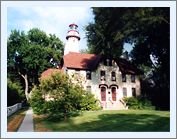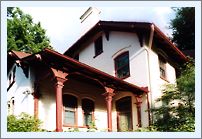|
Historical
Information

Chicago of 1870 was in a
state of tremendous industrial growth, and with that growth a pall of
thick smoke from the industries around the city enveloped the foot of
the lake, making it increasingly difficult for mariners to locate the
harbor through the gloom. As part of ongoing harbor improvements, the
Army Corps of Engineers had extended the protective piers at the river
mouth to a length of over 2,000 feet, exacerbating the task of locating
the narrow channel between the piers.
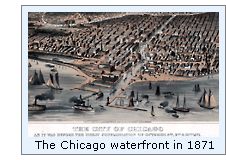 Evaluating the situation in the spring of 1870, newly appointed
Eleventh Lighthouse District Engineer Brevet Brigadier General Orlando
M. Poe recommended the establishment of a coast light to the north of
the city to serve as a leading light to guide mariners towards the
harbor entrance. After conducting a survey of the area, the decision was
made to locate this new coast light on Grosse Point, a major promontory
which lay 13 miles to the north of the harbor, and Poe requested that
funding be provided for the station’s establishment in his annual
report for that year. Congress evidently concurred with the need for the
new light station, as it appropriated $35,000 for construction in March,
1871. Evaluating the situation in the spring of 1870, newly appointed
Eleventh Lighthouse District Engineer Brevet Brigadier General Orlando
M. Poe recommended the establishment of a coast light to the north of
the city to serve as a leading light to guide mariners towards the
harbor entrance. After conducting a survey of the area, the decision was
made to locate this new coast light on Grosse Point, a major promontory
which lay 13 miles to the north of the harbor, and Poe requested that
funding be provided for the station’s establishment in his annual
report for that year. Congress evidently concurred with the need for the
new light station, as it appropriated $35,000 for construction in March,
1871.
With funding in hand, Poe’s supervised the drafting of plans and
specifications for the new station at the Detroit depot, and bids for
furnishing the construction and iron work were opened on August 13,
1872. In accordance with Federal policy, the lowest bids were accepted,
and contracts were entered into with the appropriate parties
immediately. Work at Grosse Point began in September of 1872 with the
excavation for the foundations of the tower and dwelling. When weather
caused the end of work for the season in November, all of the stonework
had been completed to grade level and the necessary drainage tile
installed. Work at the site resumed in the beginning of May 1873, with
the driving of a tight cluster of 30-foot long oak piles into the earth
to serve as a base on which the tower’s concrete and stone foundation
would be laid. By the end of June, work on the exterior of the dwelling
and a 41-foot long covered way leading to the tower were virtually
complete, and plastering of the interior walls and ceilings was well
underway. Finding costs of construction to be greater than originally
projected, an additional $15,000 was appropriated on March 3, 1873.
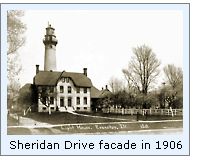 As work drew to a close towards the end of 1873, the double walled
Cream City brick tower stood 113 feet in height, with its 8-inch thick
cylindrical inner wall serving as a support for the 141-step cast iron
spiral stairway, which wound its way from ground level to the lantern
scuttle. The outer wall stood 22 feet in diameter at the foundation,
gracefully tapering to a diameter if 13 feet 3 inches at the cast iron
gallery, which was supported by 18 gracefully formed cast iron corbels.
A circular watch room was centered on the gallery, and topped by a
lantern with vertical astragals and outfitted with a huge Second Order
Fresnel lens. The lens was manufactured by the Henry-Lepaute Company of
Paris. Outfitted with a red flash panel, the lens rotated around a
three-wick lamp. Power for the rotating mechanism was provided by a
clockwork mechanism with a steel cable which was suspended within the
air space between the inner and outer tower walls. The clockwork was
carefully adjusted on a daily basis to ensure that the station’s
prescribed characteristic fixed white light with a red flash every 3
minutes. Work at the station continued through the winter of 1873 –
1874, with the station completed on March 1, 1874, in readiness for the
opening of the navigation season a few weeks later. As work drew to a close towards the end of 1873, the double walled
Cream City brick tower stood 113 feet in height, with its 8-inch thick
cylindrical inner wall serving as a support for the 141-step cast iron
spiral stairway, which wound its way from ground level to the lantern
scuttle. The outer wall stood 22 feet in diameter at the foundation,
gracefully tapering to a diameter if 13 feet 3 inches at the cast iron
gallery, which was supported by 18 gracefully formed cast iron corbels.
A circular watch room was centered on the gallery, and topped by a
lantern with vertical astragals and outfitted with a huge Second Order
Fresnel lens. The lens was manufactured by the Henry-Lepaute Company of
Paris. Outfitted with a red flash panel, the lens rotated around a
three-wick lamp. Power for the rotating mechanism was provided by a
clockwork mechanism with a steel cable which was suspended within the
air space between the inner and outer tower walls. The clockwork was
carefully adjusted on a daily basis to ensure that the station’s
prescribed characteristic fixed white light with a red flash every 3
minutes. Work at the station continued through the winter of 1873 –
1874, with the station completed on March 1, 1874, in readiness for the
opening of the navigation season a few weeks later.
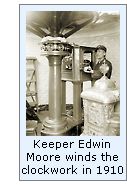 The following year it was found that the sandy shoreline in front of
the station was eroding significantly, and $5,000 was requested to abate
the problem. With finding finally available in early 1875, two large
protective timber cribs were erected in front of the station in May. The following year it was found that the sandy shoreline in front of
the station was eroding significantly, and $5,000 was requested to abate
the problem. With finding finally available in early 1875, two large
protective timber cribs were erected in front of the station in May.
As a result of implementations throughout the lighthouse system, it
was determined that the establishment of a fog signal at Grosse Point
would serve as a valuable aid to maritime commerce during periods of fog
or thick weather. To this end, a pair of buildings, 15 by 12 feet and 20
by 12 feet were erected to the east of the tower in 1880. Standing 15
feet in height, both buildings were outfitted with identical horizontal
steam boilers piped to steam-operated sirens located on the lakeward
gable end. While only one of the signals would operate at any given
time, the second was available to serve as a back up in the event of
failure of the primary signal.
After the arrival of a work crew to replace the deteriorating water
supply line from th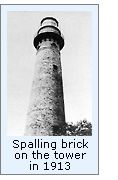 e Evanston municipal water works in 1882, the
following decade was relatively uneventful at Grosse Point, with only
routine maintenance and repairs recorded at the station. As witness to
the important role played by the station, the decision was made to
upgrade the fog signal apparatus to 10-inch locomotive-style team
whistles, whose blast was considerably louder than originally installed
sirens. Work on the north signal was completed and the new whistle
placed into operation on March 30, 1892, and the south signal activated
a month later on April 23. Prior to this time, lamp oil had been stored
in the service room which was incorporated in the covered way between
the dwelling and tower. In order to lessen the likelihood of fire
spreading throughout the station, the work crew also erected a
prefabricated circular iron oil storage building to the east of the
signal buildings. While the new steam whistles were a remarked
improvement over the smaller sirens, it took hours to get sufficient
steam raised within the boilers to activate them. To solve this problem,
water heaters were installed in 1898, allowing the keepers to build a
head of steam much more quickly, and thereby getting the whistles
screaming in less than an hour when conditions changed quickly. e Evanston municipal water works in 1882, the
following decade was relatively uneventful at Grosse Point, with only
routine maintenance and repairs recorded at the station. As witness to
the important role played by the station, the decision was made to
upgrade the fog signal apparatus to 10-inch locomotive-style team
whistles, whose blast was considerably louder than originally installed
sirens. Work on the north signal was completed and the new whistle
placed into operation on March 30, 1892, and the south signal activated
a month later on April 23. Prior to this time, lamp oil had been stored
in the service room which was incorporated in the covered way between
the dwelling and tower. In order to lessen the likelihood of fire
spreading throughout the station, the work crew also erected a
prefabricated circular iron oil storage building to the east of the
signal buildings. While the new steam whistles were a remarked
improvement over the smaller sirens, it took hours to get sufficient
steam raised within the boilers to activate them. To solve this problem,
water heaters were installed in 1898, allowing the keepers to build a
head of steam much more quickly, and thereby getting the whistles
screaming in less than an hour when conditions changed quickly.
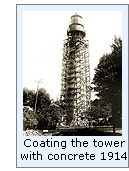 1900 was a busy year at Grosse Point, with a work crew arriving to
erect an iron fence an gate on the Sheridan Drive property line and
building a second oil house of brick, standing 8 feet by 10 feet and 12
feet in height. The work crew also raised a flag pole and poured
concrete walks connecting the front doors of the duplex dwelling to the
new Sheridan drive gate. 1900 was a busy year at Grosse Point, with a work crew arriving to
erect an iron fence an gate on the Sheridan Drive property line and
building a second oil house of brick, standing 8 feet by 10 feet and 12
feet in height. The work crew also raised a flag pole and poured
concrete walks connecting the front doors of the duplex dwelling to the
new Sheridan drive gate.
By the turn of the twentieth century, the area around the light
station had undergone a metamorphosis. At the time of the station’s
establishment 30 years earlier, the area was somewhat open, with but few
houses scattered around the area. With Chicago’s commercial success
and expansion, an increasing number of moneyed businessmen had built
mansions along the lakeshore around the light station in order to escape
the turmoil of the big city. A conflict between the need to sound the
fog signals and the peace and quiet desired by the areas gentry was
inevitable. Learning from previous experiments undertaken in Duluth in
1895 and Marquette in 1897, the Lighthouse Board installed reflectors
behind the whistles in 1901. Built on a framework of pine and sheathed
in iron, the reflectors were packed with sawdust to simultaneously
absorb sound landward, while successfully deflecting the majority of the
sound to sea. With a semblance of peace restored to the area, life again
settled into a relatively uneventful ten year period at the station. The
boat landing was re-planked in 1904, the north fog signal building
remodeled in 1905, and the illumination apparatus in the light was
upgraded from the triple wick kerosene lamp to an incandescent oil vapor
system in 1910 with an increase in output to 10,000 candlepower for the
fixed white light and 32,000 candlepower for the red flash.
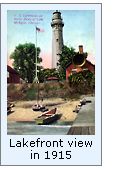 Evidently the Cream City brick used in building the Grosse Point
tower was of an inferior consistency, as Twelfth District Inspector
Lewis M. Stoddard noted the deteriorating condition of the brick during
his inspection of the station in 1913. While similar conditions had been
rectified with the installation steel casings over the brick at Big
Sable Point in 1900 and at Cana Island in 1902, Stoddard proposed a less
expensive remedy at Grosse Point. The following Spring, a work crew from
the General Cement Gun Company arrived at the station, and after erecting a wooden scaffolding around
the tower, applied a protective coating of cement to the entire tower
exterior from ground to gallery. The work was completed on May 20 at a
total cost of only $2,678.52. Evidently the Cream City brick used in building the Grosse Point
tower was of an inferior consistency, as Twelfth District Inspector
Lewis M. Stoddard noted the deteriorating condition of the brick during
his inspection of the station in 1913. While similar conditions had been
rectified with the installation steel casings over the brick at Big
Sable Point in 1900 and at Cana Island in 1902, Stoddard proposed a less
expensive remedy at Grosse Point. The following Spring, a work crew from
the General Cement Gun Company arrived at the station, and after erecting a wooden scaffolding around
the tower, applied a protective coating of cement to the entire tower
exterior from ground to gallery. The work was completed on May 20 at a
total cost of only $2,678.52.
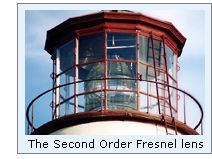 In 1935, the decision was made to automate the station, and a work
crew was dispatched to Grosse Point to undertake the work. Electricity
from the municipal utility was brought to the building, and the light
automated with the installation of an incandescent electric bulb with
automatic twin bulb changer. As part of this new installation, the lamp
was also outfitted with an automatic flash mechanism and the
characteristic of the light changed to exhibit a pair of 68,000
candlepower white flashes every 15 seconds. While the automation work
crew was on site, a large gap was found between the Assistant keeper’s
wing and the main dwelling. With the station’s automation eliminating
the need for live-in keepers, the decision was made to demolish both
this wing and the covered way connecting the tower and dwelling. In 1935, the decision was made to automate the station, and a work
crew was dispatched to Grosse Point to undertake the work. Electricity
from the municipal utility was brought to the building, and the light
automated with the installation of an incandescent electric bulb with
automatic twin bulb changer. As part of this new installation, the lamp
was also outfitted with an automatic flash mechanism and the
characteristic of the light changed to exhibit a pair of 68,000
candlepower white flashes every 15 seconds. While the automation work
crew was on site, a large gap was found between the Assistant keeper’s
wing and the main dwelling. With the station’s automation eliminating
the need for live-in keepers, the decision was made to demolish both
this wing and the covered way connecting the tower and dwelling.
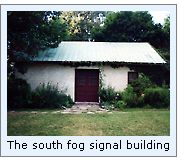 After the placement of the Grosse Point Outer Lighted Bell Buoy
offshore in 1939, it became clear that the Grosse Point light was
rendered obsolete, and the station was decommissioned in 1941 and turned
over to the City of Evanston. The building sat empty until 1944, when
the tower was used by two physicists from Northwest University to
conduct experiments in the us of infrared transmission as a form of
enhanced radar. After creation of the historic Lighthouse Park District,
the City of Evanston managed to obtain permission to have the light
reestablished as a private aid to navigation in 1946. After the placement of the Grosse Point Outer Lighted Bell Buoy
offshore in 1939, it became clear that the Grosse Point light was
rendered obsolete, and the station was decommissioned in 1941 and turned
over to the City of Evanston. The building sat empty until 1944, when
the tower was used by two physicists from Northwest University to
conduct experiments in the us of infrared transmission as a form of
enhanced radar. After creation of the historic Lighthouse Park District,
the City of Evanston managed to obtain permission to have the light
reestablished as a private aid to navigation in 1946.
With Evanston’s
conversion of the station into a museum, a major $100,000 improvement
project was undertaken during the early 1990’s to restore the
buildings to their turn of the century appearance. To this end, the
Assistant’s wing and covered way which had been removed during the
station’s automation in 1935 were both reconstructed to allow full
interpretation of the station during the height of its operation. The
majestic light station continues to serve as a museum, and is open to
the public for a small admission fee during limited hours during the
summer months.
Keepers of this
Light

Click Here to see a complete listing of
all Grosse Point Light keepers compiled by Phyllis L. Tag of Great Lakes
Lighthouse Research.
Seeing this
Light

Directions will be forthcoming after we visit this light in the Spring of
2001.
Contact information

Lighthouse Park District
2601 Sheridan Road
Evanston, IL 60201-1752
Telephone: 847.328.6961
Website: www.grossepointlighthouse.org
Email:lpdnhl@grossepointlighthouse.org
Reference Sources
Annual reports of the
Lighthouse Board, various, 1871 – 1909
Annual reports of the Lighthouse Service, various, 1910 – 1929
Annual reports of the Lake Carriers Association, 1903 – 1939
Great Lakes Light Lists, various, 1873 - 1999
Lewis M. Stoddard note book, Michigan Lighthouse Conservancy
collection
Statutes at Large, 42nd Congress, 3rd Session , March 3,
1873
Grosse Point Light Station - National Historic Landmark Study - by
Donald J. Terras
The Keeper’s Log, United States Lighthouse Society, Fall 1993
Keeper listings for this light
appear courtesy of Great
Lakes Lighthouse Research
|
